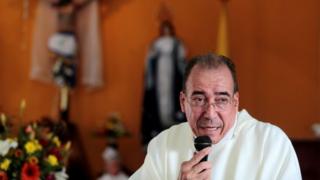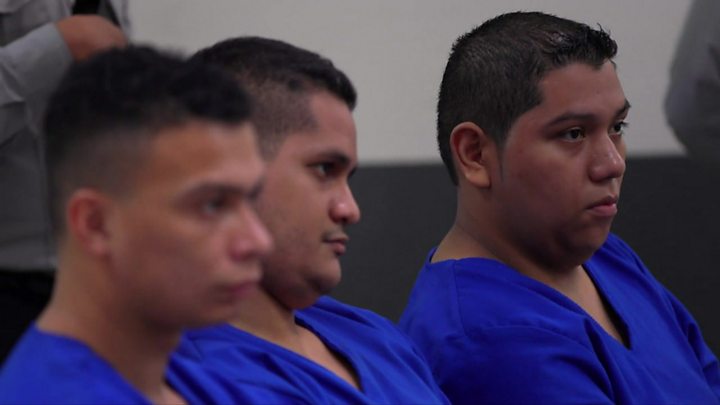Home » Latin America »
Nicaraguan mothers mourn on eve of revolution’s anniversary
The people of Masaya say rebellion runs in their blood. But there is no-one in the Nicaraguan city of whom that is more true than Father Edwin Román.
“Sandino was my grandmother’s brother, my great-uncle,” says the priest of Nicaragua’s revolutionary hero and rebel leader, Augusto César Sandino.
Few can boast such a direct familial link to the man who ended the United States’ occupation of Nicaragua in 1933 and whose name would become synonymous with another revolution in Nicaragua decades later.
Sandino’s great-nephew is a quieter kind of rebel.
At the height of the violent anti-government protests which rocked Masaya last year, Fr Román sheltered dozens of demonstrators in his church as they were being fired upon by police and armed left-wing radicals.
He also turned the clergy house into a makeshift triage unit for the injured. “The doorbell rang and there was a group of kids with blood streaming from their heads. From 7pm until the following morning, with the support of a few local medical students, we attended to anyone who arrived at our door,” he recalls.
Key dates:
Such actions as well as his outspoken sermons, which have been openly sympathetic to the opposition cause, have brought him pressure from the governing Sandinista National Liberation Front (FSLN).
On Friday, the governing party will be marking the 40th anniversary of the day when Sandinista rebels, who had named themselves after Fr Román’s great-uncle, defeated the US-backed military ruler Anastasio Somoza.
But on the eve of the anniversary, Fr Román has little positive to say about the group carrying Sandino’s name and their leader who is now Nicaragua’s president, Daniel Ortega.
“The Sandinistas have achieved nothing. We’re repeating a cycle of dictatorship. The guerrilla fighter who defeated Somoza has today become the dictator himself,” he says of Mr Ortega.
Change for the better?
One of the turning points in the war against Somoza was an audacious and daring attack on the National Palace in 1978, a year before the rebels took power.
Twenty-five guerrillas, dressed as National Guard elite troops, stormed Congress while it was in full session and took the lawmakers hostage.
The man who led the near-suicidal operation, Edén Pastora, also known as Comandante Cero, does not share the priest’s dismal assessment of the FSLN’s legacy.
“When we won, we aimed to change the social, political and economic structure of the country, particularly for the rural, indigenous population through agrarian reform and a national literacy programme.” he says. “To be a worker in the times of Somoza was to be considered practically a common criminal,” he recalls.
He argues that it was the return of Daniel Ortega to power in 2007 – he had ruled the country for most of the 1980s – that made the biggest impact.
“We’re the country with most growth in Latin America after Panama and the Dominican Republic,” he insists before listing supposed improvements in energy, healthcare and infrastructure.
Critics of the government say many such claims by high-ranking Sandinistas are misleading. They argue that they are either based on a totalitarian control of the economy, which has only benefitted an inner circle, has weakened state institutions and bypassed the rule of law, or that they are simply untrue.
Memories of revolution
The walls of Edén Pastora’s office are adorned with framed photographs of a revolutionary life: one alongside the late Cuban leader Fidel Castro, another with his comrades in a clandestine hideout and, above his desk, a famous image of him after the National Palace assault, hoisting his rifle aloft.
Today, in his 80s, Comandante Cero has a slight tremble in his hands. Yet when it comes to Nicaragua’s current conflict and the more than 300 people who died during last year’s wave of anti-government protests, he remains as firm and unrepentant as ever, echoing the FSLN party line.
“There was real chaos on the streets and we had to defend ourselves. We were facing terrorists here. They killed our police officers, stabbed, shot, burned them, stoned them with rocks. You can see it in the videos,” he says of the response to the anti-government protests by the security forces, which the United Nations has condemned as “repressive”.
Hundreds of protesters have also been put on trial, with some facing charges of terrorism.
Yet even die-hard Sandinistas like Edén Pastora would find it hard to describe Sandor Dolmusas as a “terrorist”.
The unarmed 15-year-old altar boy with plans of joining the priesthood one day was killed by a bullet to the chest from a high-calibre weapon in June of last year.
His mother, Ivania, points out the spot outside the family home in the town of León where his body crumpled to the ground as he stood near a barricade erected as part of the anti-government protests.
The home is a ramshackle building in the city of León shared by the extended family. Scrawny chickens peck inside cages while Sandor’s grandmother cooks tortillas over a fire in the patio.
United in grief
A group of local women who, like Ivania, lost their sons last year during the protests have gathered in the main room. Through tears, they show me photos of their boys, bloodied and dying in the streets of León.
Ivania says the ultimate responsibility for her son’s death lies with President Ortega. “If not with him, then with whom? The police and paramilitaries just follow orders from above.”
While the regional body the Organization of American States is helping the mothers seek justice against the Ortega government, a meaningful trial of those responsible is unlikely to happen in Nicaragua while the Sandinistas remain in power.
Still, the mothers hope the deaths of their sons will not have been in vain.
“Sandor is a symbol for Nicaragua and across Central America. Even Pope Francis heard about what happened to him,” says Ivania.
“He touched people’s hearts but in the very worst way, in death. They took away his hope.”
Source: Read Full Article




